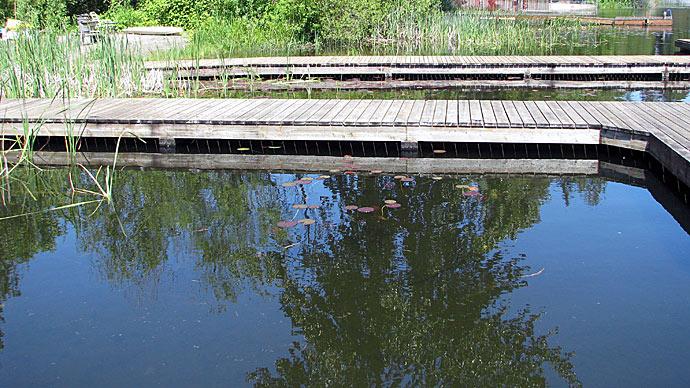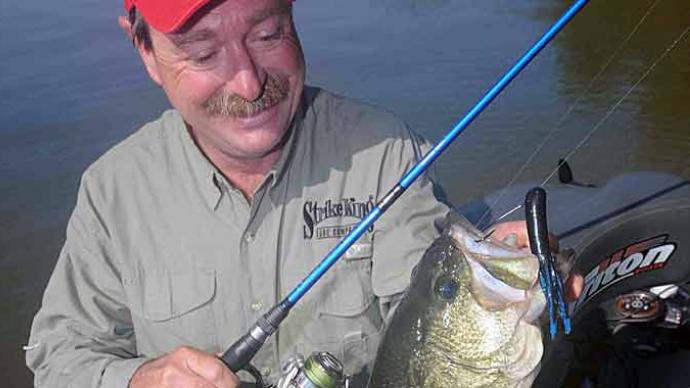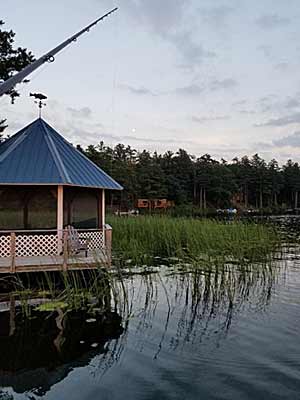
Bass love shallow-water cover. Anglers love it, too, even if they don’t get a bite. There’s satisfaction in putting a lure directly on a visual target. Two of the best are aquatic vegetation and boat docks. But they’re even better when you find them together.
Docks with aquatic vegetation — submerged or emergent — are twice as nice to bass as ones that lack it. They attract more baitfish, offer protection from changing conditions, and provide better concealment from their next meal. While your chances of catching bass increase at any intersection of these two types of cover, they’re even better if you concentrate on the edges.
Edges are created where two types of cover meet. They’re prevalent in all waters. They can be where clay and sand come together in deep water or gravel tapers into larger rocks. It can be where a tree line meets open water as it winds along a submerged creek channel. And they’re found where a dock and its associated structures cut into a bed of aquatic vegetation.
Bass use edges in several ways, depending on their depth and orientation. Ones that cross open water from deep to shallow are highways, so to speak, giving bass a migration route to where they spawn in spring and feast on baitfish in the fall. Edges are used for feeding, too. For example, points and pockets along the edges of beds of aquatic vegetation offer ambush spots. Bass also herd baitfish into edges, where they are easier to catch.
When to fish docks surrounded by aquatic vegetation isn’t much question. The combination produces plenty of largemouth and sometimes smallmouth, including big ones, from the time grass starts growing in spring until it dies back in late fall. Inside grass lines around docks, for example, are productive places to fish from late summer through early fall. The real question is deciding how to approach all the edges.
All about shade
Docks cut edges into aquatic vegetation in several ways. Their structure, such as posts and hoists, knock holes in beds. But their horizontal surfaces, from decking to boat-house roofs, do most of the work. They throw plenty of shade, keeping grass from growing under and to a certain extent around a dock.
The shade created by docks does more than cut down on aquatic vegetation. The low level of light attracts baitfish and provides bass with a level of comfort, letting them hunt without detection. Add in the grass edges, which provide ambush spots for bass and hiding places for baitfish, and it’s a perfect spot.
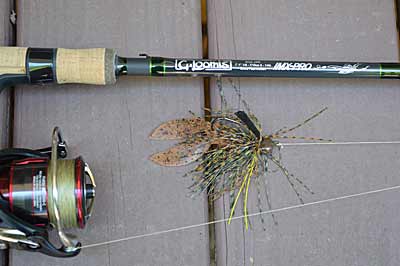
While a dock’s shade is the bass’s friend, the sun is yours. Cloudy and rainy days are traditional favorites, with bass anglers when light levels are low. Bass like them, too. The added security makes them active and aggressive, giving them the confidence to roam farther in random directions. But when the sun shines, they retreat to cover, deep into a bed of aquatic vegetation or under a dock. That makes it easier to put your casts in high-percentage places instead of fan-casting large stretches to keep up with a moving target.
Hit the mats
Aquatic vegetation doesn’t have to sprout from the bottom to make a dock more attractive to bass. Mats of grass grow in the shallow water where docks are found. And wind and waves will push and wash pieces of cut grass, whether from a mechanical harvester or lopped off by boat-engine props. They’ll collect around docks, creating small mats.
Bass hold under even the shallowest of these small mats, using them as an extension of the overhead cover provided by the host dock. You’ll have two approaches for fishing them. The first is over the top with a hollow-body frog or soft-plastic toad. But heavier weedless spoons, such as a Johnson Silver Minnow, can be a better choice. Their weight causes them to ride lower on the mat, creating a bigger disturbance, which attracts bass and puts its hook in a better position.
Jigs and Texas-rigged soft plastics should be your go-to choices when going through mats or under docks to catch bass. The best ones have sizes, colors, and actions that mimic crawfish or panfish, all of which are found in large numbers around docks and aquatic vegetation. They should be short and bulky and push plenty of water. That, combined with a slow fall, make them easy for bass to find around heavy grass and in low-light conditions.
Even more important than lure selection is your presentation. Always work your lure along an edge, whether where an object creates a hole in the aquatic vegetation, sun meets shade, or matted grass meets open water, the dock, or shore. Aim for any points or pockets along those edges. And don’t be afraid to work just inside the vegetation. Hanging your lure in it than shaking it free can ignite a strike.
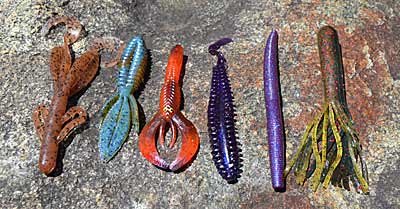
Most anglers reach for a casting rod to put their lure in these spots. Its leverage and ability to handle heavy lines bring reassurance around wood, metal, and thick vegetation, which all hooked bass can use to free themselves. Putting your lure around and under cover requires a precise presentation such as skipping. But doing that with casting gear requires skill, practice, and patience — waiting for the best angle and picking out the inevitable backlash. So, try a spinning rod.
A fast-action spinning rod sporting a medium-heavy or heavy power has the right flex and backbone to put lures, including small jigs, stick worms, and Texas-rigged craws, on target and wrestle big bass back out. Match it to a 3000-series spinning reel, whose large-diameter spool lets line loose easily and with few if any tangles, and you can concentrate on creating the perfect skips rather than backlashes.
Load your spinning reel with braided line. It packs a lot of punch in a small package — 20-pound test, for example, has the same diameter of 6-pound test monofilament. It’s easy to cast and resists abrasions, meaning you worry less about break-offs, no matter how many pilings a bass wraps you around. A direct tie to your lure; low light and heavy cover negates the need for a monofilament or fluorocarbon leader.
Check adjacent spots
Docks offer a compact package — decking, posts, and lifts are tied together. But there’s plenty more to fish around docks where aquatic vegetation is present.
Many docks across the northern stretch of the United States, especially older ones, sit on cribs. They are built of timbers set in a log-cabin style and filled with rocks. Those crevices make docks built with them more attractive than those without them. But ones found away from the dock can be even better.
As docks are removed, expanded, or reconfigured, often after a bad winter, when ice takes out the decking, new cribs are built, and older ones are abandoned. With the shade from the decking removed, aquatic vegetation sprouts, creating a rock-and-wood pile surrounded by four grass edges. And being a short distance from a dock, they provide bass with a second-place to feed and hold.
Finding old cribs is easy in clear water. You’ll see most of them when you get close, though the square opening they create in aquatic vegetation beds is a giveaway at further distances. The opening may be your only clue to a crib’s location in stained water.
Docks usually accompany waterside homes, which require a water supply to meet drinking, bathing, irrigation, and other needs. Some pull that water straight from the adjacent lake, river, or reservoir. The ends of these water lines are anchored with heavy objects such as cinder blocks and are usually marked with a buoy. Like cribs, these anchors open spaces and create edges within aquatic vegetation beds, attracting prey and predators. So, when you see a float in open water, always aim a cast or two at it.
Boat moorings are marked the same as water lines. Usually held in place by weight with bigger bulk, they offer the same benefits to bass and a few more. They are often in slightly deeper water and can occur in large groupings, usually outside a marina, pockmarking a bed with many open spots, each capable of attracting a bass or two.
Sailboats have the unique ability to enhance the holes that their moorings create. As the wind swings them around their moorings, their keels make swathes through the vegetation. So, there can be large open areas underneath them, especially those that don’t see much use.
BassResource may receive a portion of revenues if you make a purchase using a link above.


